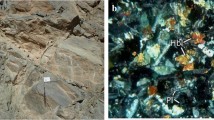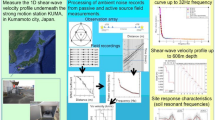Abstract
A detailed field investigation of P- and S-wave velocities was carried out for the Wyoming trona deposit. The velocity measurement was performed at two field sites and included 11 transmission surveys. A total of 97 independent ray paths were generated from these surveys and utilized for the velocity calculation. The test sites consisted of two large pillars. The average travel distance of the signals utilized for the survey was 100 m. A high resolution data acquisition system was used with the sampling rate set at 50 kHz. The sensors were high sensitive accelerometers, with a flat response range of 50–5,000 Hz. These sensors were installed in the boreholes to avoid the attenuation problem caused by the fractured pillar surface. A special sensor installation technique was employed for reliable sensor installation in boreholes which could be oriented in any directions. The signals acquired from the transmission surveys were of very high quality. The frequencies of these signals were very high, ranged from 2,500 to 5,000 Hz, with 5,000 Hz being most typical. The P- and S-waves were well defined and separated. The timing error was estimated within 0.05 ms. The velocities calculated for all 97 survey lines were very consistent. The average P- and S-wave velocities were 5,108 and 2,640 m/s, respectively. The mean standard deviations were small, only 2.4 and 1.9 % for the P- and S-wave velocities. The 95 % two-sided confidence interval for the true P-wave velocity was 5,108 ± 24 m/s and for the S-wave velocity was 2,640 ± 10 m/s. With the consideration of the test conditions associated with this investigation, including multiple test sites, large pillars, excellent signal quality, a very large database, and extremely consistent results, we believe that the P- and S-wave velocities determined from this investigation are accurate, reliable and representative for the Wyoming trona deposit.









Similar content being viewed by others
References
Dresen L, Ruter H (1994) Seismic coal exploration, Part B: in-seam seismics. Pergamon, New York
Evison FF (1955) A coal seam as a guide for seismic energy. Nature 176:1224–1225
Ge M (2006). An in-seam seismic (ISS) method based mine void detection technique. Final report for phase I of geo-physical void detection demonstrations (MSHA B2532532), submitted to U.S. Department of Labour, Mine Safety and Health Administration, October 29, 2006, 227 pp
Ge M, Wang H, Hardy HR Jr, Ramani R (2007) Void detection at an anthracite mine using an in-seam seismic method. Int J Coal Geol 73:201–212
Ge M, Wang H, Schissler A, Ramani R (2012) Pillar width measuring in trona mines with a body wave based in-seam seismic technique. Int J Rock Mech Min Sci 53:10–17
Hines WW, Montgomery DC (1980) Probability and statistics in engineering and management science, 2nd edn. Wiley, New York
Kostick DS (2007) Soda ash, in U.S. Geological Survey Mineral Commodity Summaries, 2006, pp 150–151
Krey T (1963) Channel waves as a tool of applied geophysics in coal mining. Geophysics 28:701–714
Leigh RT (1997) Wyoming Trona—an overview of the geology. In: Jones RW, Harris RE (eds) Proceedings of the 32nd annual forum of industrial minerals—Laramie, Wyoming, May 19–21, 1996: Wyoming State Geological Survey Public Information Circular, vol 38, p 319
Acknowledgments
We thank FMC and General Chemical for their support and participation in the project. In particular, we thank R. Steenberg, Mine Manager of FMC, and S. Britton, formally Manager Mining Operations of General Chemical for their vision and their efforts in the initiation of this case study at the trona mines. Several other people at these two mines provided direct assistance to the tests, including R. Kramer, G. Shelton, C. Pritchard, J. Norgord, D. Graham, T. L. Mink, K. Mullins, and M. Richardson. We thank three anonymous reviewers for their comments and suggestions to improve the manuscript. This work was funded by the U.S. Mine Safety and Health Administration (MSHA) Project B2532532.
Author information
Authors and Affiliations
Corresponding author
Rights and permissions
About this article
Cite this article
Ge, M., Wang, H. Field Measurement of P- and S-Wave Velocities for Wyoming Trona Deposit. Geotech Geol Eng 31, 387–399 (2013). https://doi.org/10.1007/s10706-012-9583-5
Received:
Accepted:
Published:
Issue Date:
DOI: https://doi.org/10.1007/s10706-012-9583-5




